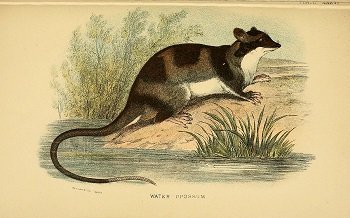
So, how exactly do yapoks manage to do this? Well, their survival strategies are nothing short of fascinating. They’ve developed a unique set of skills and physical traits that help them thrive in environments ranging from rivers and swamps to less hospitable places. Let’s dive into the world of yapoks and explore the incredible ways they manage to survive against the odds.
Physical Adaptations
One of the first things that stand out about yapoks is their physical traits. These adaptations are crucial for their survival. For starters, they have webbed feet that make them agile swimmers. Think about how a duck glides effortlessly through water—yapoks do something similar, allowing them to escape predators and hunt for food beneath the surface.
In addition to their webbed feet, yapoks have a layer of fat beneath their skin, which acts like a life jacket. This fat not only provides insulation against cold waters but also helps them stay buoyant. Imagine trying to swim while wearing a winter coat; it would be hard! But for yapoks, this fat layer means they can swim without much effort. They’re truly designed for life in the water.
Furthermore, their fur is dense and waterproof, keeping them warm and dry. If you’ve ever tried to stay warm in a wet t-shirt on a chilly day, you know how important this feature is. Yapoks don’t just survive in harsh conditions; they thrive!
Behavioral Strategies
Yapoks are not just about physical strengths; they also employ clever behavioral strategies to adapt to their environment. One of their most impressive tricks is their ability to forage for food at night, making them nocturnal hunters. This means they avoid competition with other animals and can take advantage of the cover of darkness.
Their diet consists mainly of crustaceans, fish, and insects found in the water, which means they’re constantly on the lookout for their next meal. Imagine wandering through a buffet in the dark—yapoks have honed this skill to perfection. They can even dive underwater and hold their breath for several minutes while searching for dinner!
When it comes to safety, yapoks exhibit interesting social behavior. They are known to live in small family groups, which offers protection against predators. It’s like forming a small team to watch each other’s backs! This not only increases their safety but also improves their chances of finding food together.
Water-Dependent Lifestyle
Yapoks are true water lovers, and their reliance on aquatic environments is a key factor in their survival. They are known for their semi-aquatic lifestyle, spending much of their time in and around water bodies. Living near rivers and swamps provides them with a reliable food source and a place to hide from threats.
Water is their lifeline, and they’ve adapted to make the most of it. For instance, yapoks can often be seen climbing onto riverbanks or lounging on branches overhanging the water. This not only gives them easy access to food but also allows them to quickly escape if danger approaches. Imagine having a front-row seat to all the action while sitting on a comfy branch!
Furthermore, their ability to dive and swim effortlessly means they can quickly relocate to safer areas when necessary. If a predator gets too close, a swift dive into the water can be a lifesaver. It’s all about making the most of their surroundings!
Adaptation to Climate Extremes
Yapoks are found in a variety of climates, from tropical rainforests to temperate regions. Interestingly, they have developed ways to cope with extreme weather conditions. For example, during dry seasons, when water sources may dwindle, they can be less active and conserve energy. It’s like going into hibernation mode, but not quite!
When faced with the harshness of winter, yapoks utilize their thick fur and body fat to stay warm. This insulation helps them endure cooler temperatures that would otherwise be a challenge. They are nature’s little survivors, ready to face what the elements throw their way!
Additionally, their keen sense of smell plays a significant role in adapting to environmental changes. Yapoks can sense when water is close, guiding them to safe habitats even in unfamiliar areas. It’s like they have an internal GPS tuned to water sources!
Unique Reproductive Traits
Just like their survival methods, yapoks have unique reproductive traits that assist in their ability to thrive. Female yapoks have a pouch where they carry and nurture their young. This not only provides protection but ensures that the babies have a safe place to grow while their mothers navigate tricky environments.
The babies are born underdeveloped, but they quickly find their way into the pouch. This nurturing method is crucial for survival, especially in harsher habitats where food is scarce. It’s like starting life in a safe bubble, allowing them to build the strength they need before facing the outside world.
As they grow, the young yapoks gradually learn to swim and forage with their mothers. This family-oriented approach means they can pass on survival skills to the next generation, ensuring their species continues to thrive, even in challenging environments.
Yapoks may not be the most famous mammals out there, but their survival strategies in harsh environments are nothing short of amazing. With their unique adaptations, clever behaviors, and ability to thrive in diverse habitats, they demonstrate the resilience of life. Whether it’s their physical traits, behavioral strategies, or incredible reproductive methods, each aspect helps them to thrive where other animals might falter.
Next time you think about the wonders of nature, remember our little friends, the yapoks. They’re a fascinating reminder that life can flourish even in the most unexpected places, and sometimes, all it takes is a little adaptability and creativity to truly survive.
